BMW MOTORRAD K 1200 S 2007 Rider's Manual (in English)
Manufacturer: BMW MOTORRAD, Model Year: 2007, Model line: K 1200 S, Model: BMW MOTORRAD K 1200 S 2007Pages: 166, PDF Size: 2.8 MB
Page 71 of 166
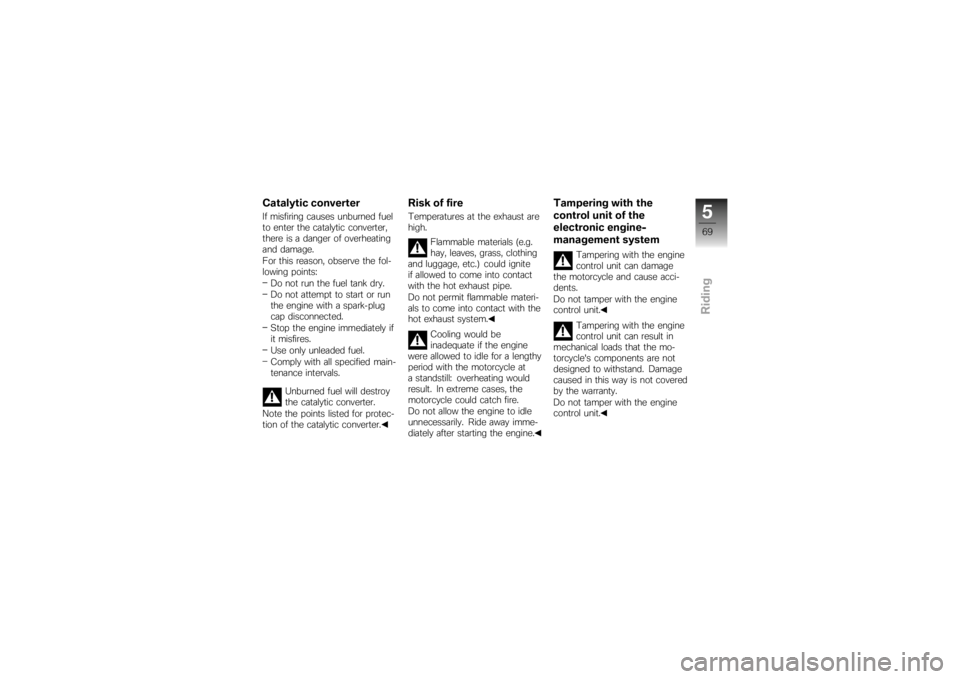
Catalytic converterIf misfiring causes unburned fuel
to enter the catalytic converter,
there is a danger of overheating
and damage.
For this reason, observe the fol-
lowing points:Do not run the fuel tank dry.
Do not attempt to start or run
the engine with a spark-plug
cap disconnected.
Stop the engine immediately if
it misfires.
Use only unleaded fuel.
Comply with all specified main-
tenance intervals.
Unburned fuel will destroy
the catalytic converter.
Note the points listed for protec-
tion of the catalytic converter.
Risk of fireTemperatures at the exhaust are
high.
Flammable materials (e.g.
hay, leaves, grass, clothing
and luggage, etc.) could ignite
if allowed to come into contact
with the hot exhaust pipe.
Do not permit flammable materi-
als to come into contact with the
hot exhaust system.
Cooling would be
inadequate if the engine
were allowed to idle for a lengthy
period with the motorcycle at
a standstill: overheating would
result. In extreme cases, the
motorcycle could catch fire.
Do not allow the engine to idle
unnecessarily. Ride away imme-
diately after starting the engine.
Tampering with the
control unit of the
electronic engine-
management system
Tampering with the engine
control unit can damage
the motorcycle and cause acci-
dents.
Do not tamper with the engine
control unit.
Tampering with the engine
control unit can result in
mechanical loads that the mo-
torcycle's components are not
designed to withstand. Damage
caused in this way is not covered
by the warranty.
Do not tamper with the engine
control unit.
569zRiding
Page 72 of 166
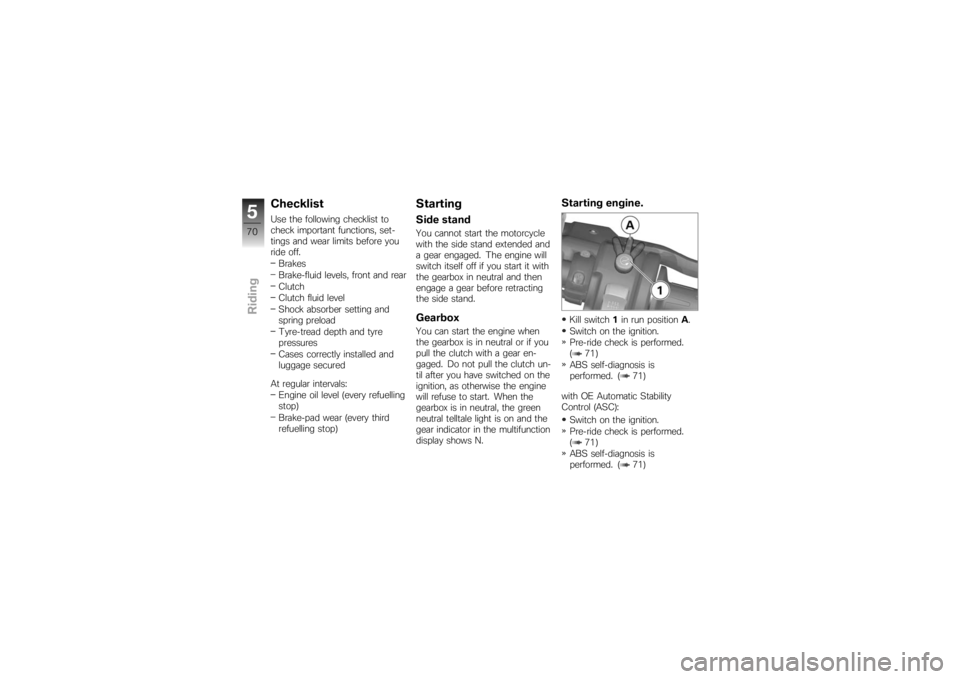
ChecklistUse the following checklist to
check important functions, set-
tings and wear limits before you
ride off.Brakes
Brake-fluid levels, front and rear
Clutch
Clutch fluid level
Shock absorber setting and
spring preload
Tyre-tread depth and tyre
pressures
Cases correctly installed and
luggage secured
At regular intervals: Engine oil level (every refuelling
stop)
Brake-pad wear (every third
refuelling stop)
StartingSide standYou cannot start the motorcycle
with the side stand extended and
a gear engaged. The engine will
switch itself off if you start it with
the gearbox in neutral and then
engage a gear before retracting
the side stand.GearboxYou can start the engine when
the gearbox is in neutral or if you
pull the clutch with a gear en-
gaged. Do not pull the clutch un-
til after you have switched on the
ignition, as otherwise the engine
will refuse to start. When the
gearbox is in neutral, the green
neutral telltale light is on and the
gear indicator in the multifunction
display shows N.
Starting engine.Kill switch 1in run position A.
Switch on the ignition.
Pre-ride check is performed.
( 71)
ABS self-diagnosis is
performed. ( 71)
with OE Automatic Stability
Control (ASC): Switch on the ignition.
Pre-ride check is performed.
( 71)
ABS self-diagnosis is
performed. ( 71)
570zRiding
Page 73 of 166
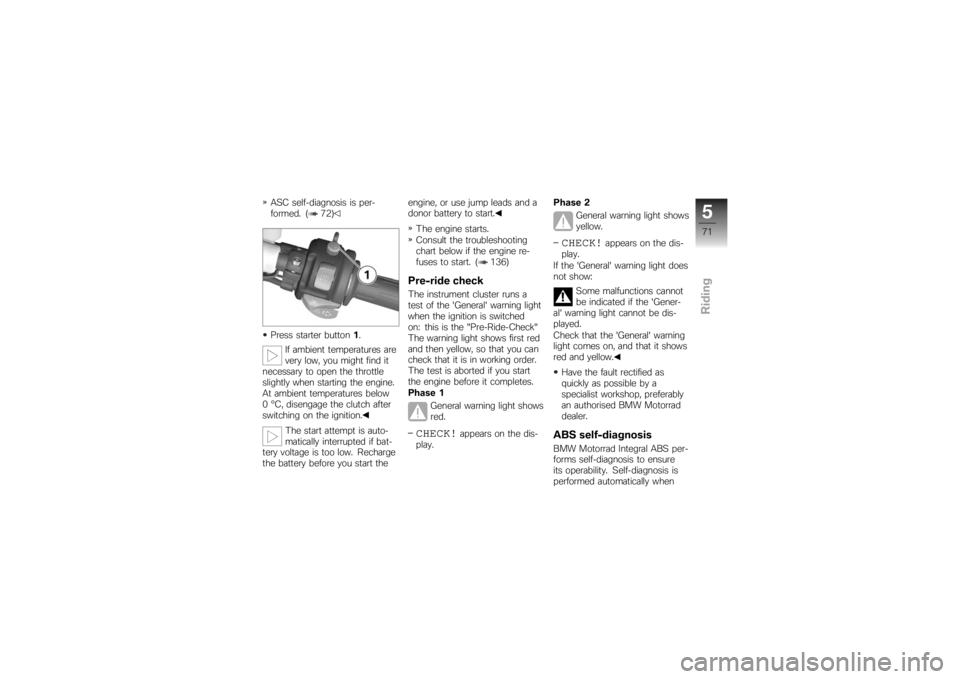
ASC self-diagnosis is per-
formed. ( 72)
Press starter button1.
If ambient temperatures are
very low, you might find it
necessary to open the throttle
slightly when starting the engine.
At ambient temperatures below
0 °C, disengage the clutch after
switching on the ignition.
The start attempt is auto-
matically interrupted if bat-
tery voltage is too low. Recharge
the battery before you start the engine, or use jump leads and a
donor battery to start.
The engine starts.
Consult the troubleshooting
chart below if the engine re-
fuses to start. ( 136)
Pre-ride checkThe instrument cluster runs a
test of the 'General' warning light
when the ignition is switched
on: this is the "Pre-Ride-Check"
The warning light shows first red
and then yellow, so that you can
check that it is in working order.
The test is aborted if you start
the engine before it completes.
Phase 1 General warning light shows
red.CHECK!
appears on the dis-
play. Phase 2
General warning light shows
yellow.
CHECK!
appears on the dis-
play.
If the 'General' warning light does
not show:
Some malfunctions cannot
be indicated if the 'Gener-
al' warning light cannot be dis-
played.
Check that the 'General' warning
light comes on, and that it shows
red and yellow.
Have the fault rectified as
quickly as possible by a
specialist workshop, preferably
an authorised BMW Motorrad
dealer.
ABS self-diagnosisBMW Motorrad Integral ABS per-
forms self-diagnosis to ensure
its operability. Self-diagnosis is
performed automatically when
571zRiding
Page 74 of 166
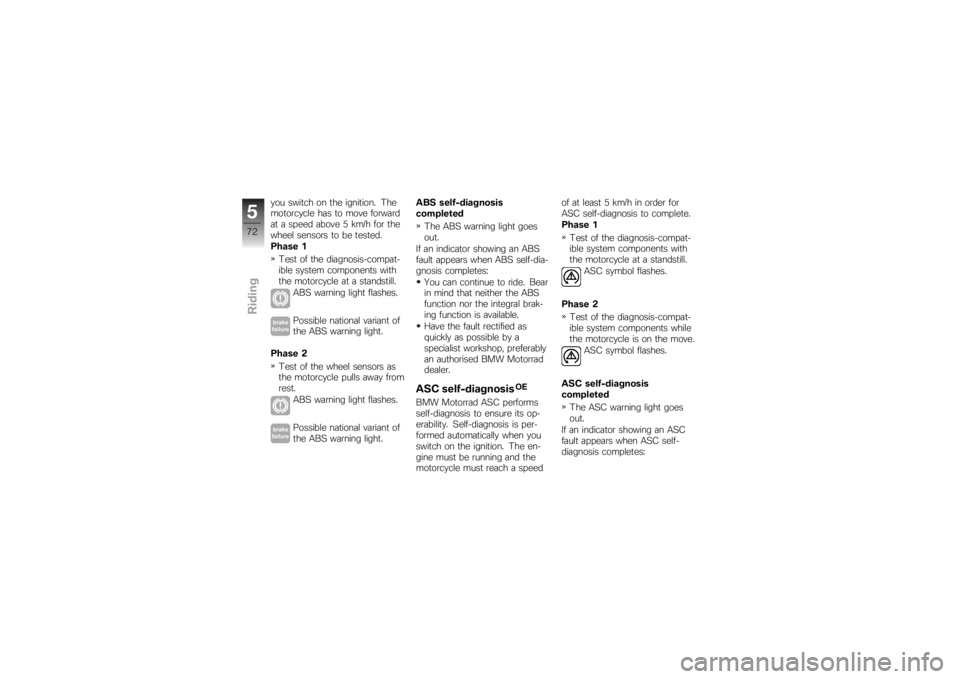
you switch on the ignition. The
motorcycle has to move forward
at a speed above 5 km/h for the
wheel sensors to be tested.
Phase 1Test of the diagnosis-compat-
ible system components with
the motorcycle at a standstill. ABS warning light flashes.
Possible national variant of
the ABS warning light.
Phase 2 Test of the wheel sensors as
the motorcycle pulls away from
rest. ABS warning light flashes.
Possible national variant of
the ABS warning light. ABS self-diagnosis
completed
The ABS warning light goes
out.
If an indicator showing an ABS
fault appears when ABS self-dia-
gnosis completes:
You can continue to ride. Bear
in mind that neither the ABS
function nor the integral brak-
ing function is available.
Have the fault rectified as
quickly as possible by a
specialist workshop, preferably
an authorised BMW Motorrad
dealer.
ASC self-diagnosis
OE
BMW Motorrad ASC performs
self-diagnosis to ensure its op-
erability. Self-diagnosis is per-
formed automatically when you
switch on the ignition. The en-
gine must be running and the
motorcycle must reach a speed of at least 5 km/h in order for
ASC self-diagnosis to complete.
Phase 1
Test of the diagnosis-compat-
ible system components with
the motorcycle at a standstill. ASC symbol flashes.
Phase 2 Test of the diagnosis-compat-
ible system components while
the motorcycle is on the move. ASC symbol flashes.
ASC self-diagnosis
completed The ASC warning light goes
out.
If an indicator showing an ASC
fault appears when ASC self-
diagnosis completes:
572zRiding
Page 75 of 166
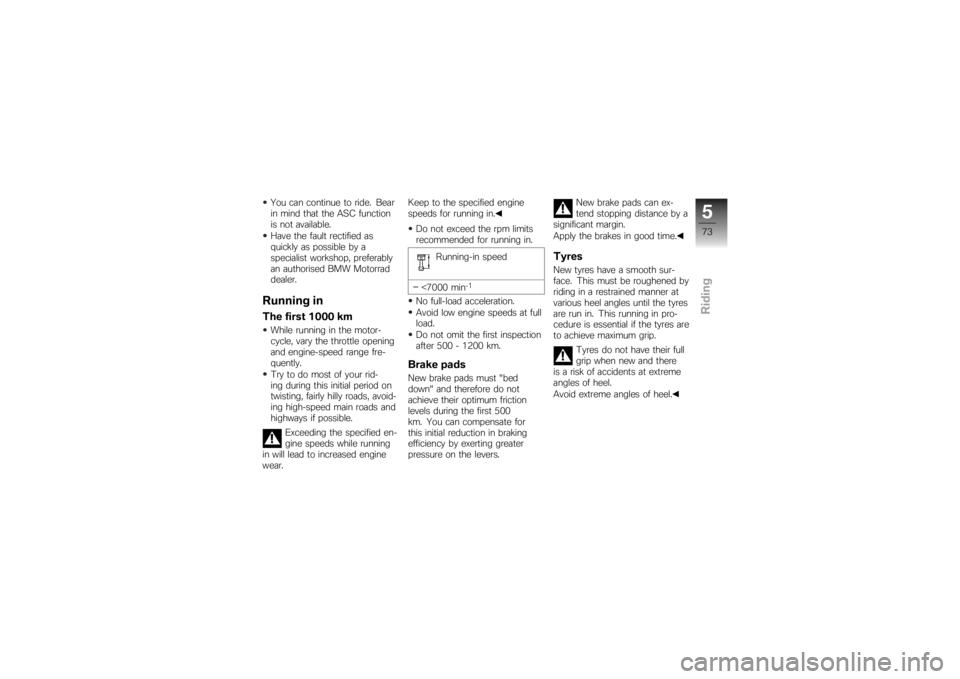
You can continue to ride. Bear
in mind that the ASC function
is not available.
Have the fault rectified as
quickly as possible by a
specialist workshop, preferably
an authorised BMW Motorrad
dealer.Running inThe first 1000 kmWhile running in the motor-
cycle, vary the throttle opening
and engine-speed range fre-
quently.
Try to do most of your rid-
ing during this initial period on
twisting, fairly hilly roads, avoid-
ing high-speed main roads and
highways if possible.Exceeding the specified en-
gine speeds while running
in will lead to increased engine
wear. Keep to the specified engine
speeds for running in.
Do not exceed the rpm limits
recommended for running in.
Running-in speed
<7000 min
-1
No full-load acceleration.
Avoid low engine speeds at full
load.
Do not omit the first inspection
after 500 - 1200 km.Brake padsNew brake pads must "bed
down" and therefore do not
achieve their optimum friction
levels during the first 500
km. You can compensate for
this initial reduction in braking
efficiency by exerting greater
pressure on the levers. New brake pads can ex-
tend stopping distance by a
significant margin.
Apply the brakes in good time.
TyresNew tyres have a smooth sur-
face. This must be roughened by
riding in a restrained manner at
various heel angles until the tyres
are run in. This running in pro-
cedure is essential if the tyres are
to achieve maximum grip.
Tyres do not have their full
grip when new and there
is a risk of accidents at extreme
angles of heel.
Avoid extreme angles of heel.
573zRiding
Page 76 of 166
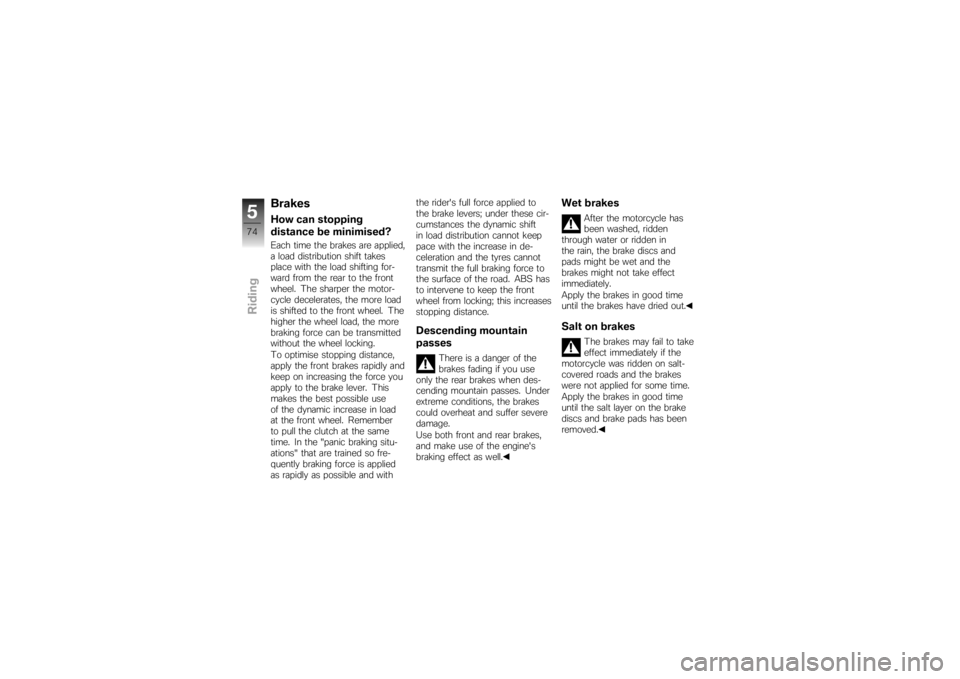
BrakesHow can stopping
distance be minimised?Each time the brakes are applied,
a load distribution shift takes
place with the load shifting for-
ward from the rear to the front
wheel. The sharper the motor-
cycle decelerates, the more load
is shifted to the front wheel. The
higher the wheel load, the more
braking force can be transmitted
without the wheel locking.
To optimise stopping distance,
apply the front brakes rapidly and
keep on increasing the force you
apply to the brake lever. This
makes the best possible use
of the dynamic increase in load
at the front wheel. Remember
to pull the clutch at the same
time. In the "panic braking situ-
ations" that are trained so fre-
quently braking force is applied
as rapidly as possible and withthe rider's full force applied to
the brake levers; under these cir-
cumstances the dynamic shift
in load distribution cannot keep
pace with the increase in de-
celeration and the tyres cannot
transmit the full braking force to
the surface of the road. ABS has
to intervene to keep the front
wheel from locking; this increases
stopping distance.
Descending mountain
passes
There is a danger of the
brakes fading if you use
only the rear brakes when des-
cending mountain passes. Under
extreme conditions, the brakes
could overheat and suffer severe
damage.
Use both front and rear brakes,
and make use of the engine's
braking effect as well.
Wet brakes
After the motorcycle has
been washed, ridden
through water or ridden in
the rain, the brake discs and
pads might be wet and the
brakes might not take effect
immediately.
Apply the brakes in good time
until the brakes have dried out.
Salt on brakes
The brakes may fail to take
effect immediately if the
motorcycle was ridden on salt-
covered roads and the brakes
were not applied for some time.
Apply the brakes in good time
until the salt layer on the brake
discs and brake pads has been
removed.
574zRiding
Page 77 of 166
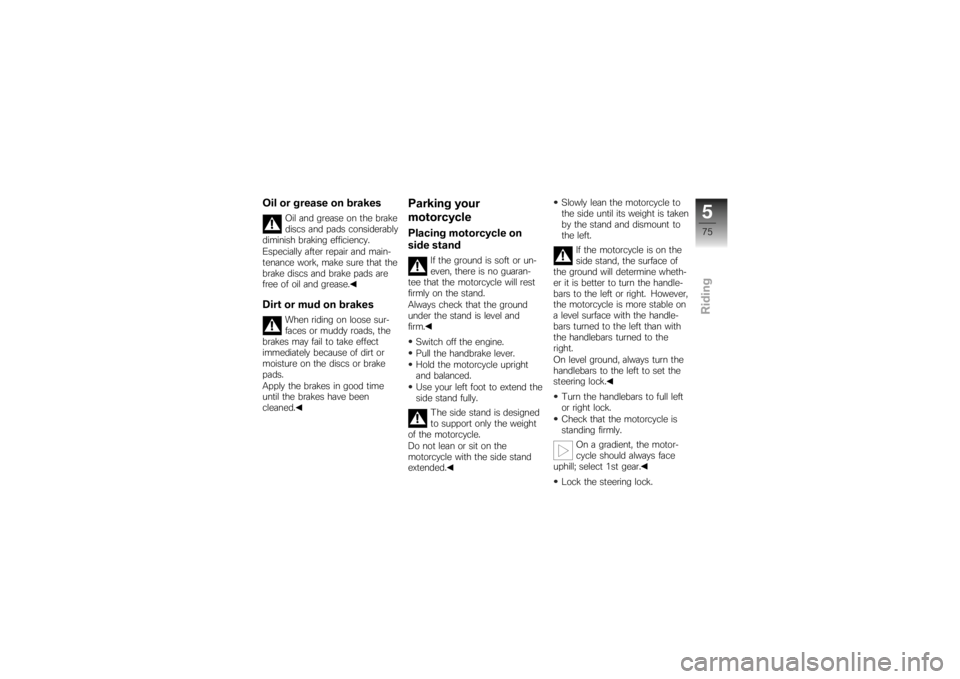
Oil or grease on brakes
Oil and grease on the brake
discs and pads considerably
diminish braking efficiency.
Especially after repair and main-
tenance work, make sure that the
brake discs and brake pads are
free of oil and grease.
Dirt or mud on brakes
When riding on loose sur-
faces or muddy roads, the
brakes may fail to take effect
immediately because of dirt or
moisture on the discs or brake
pads.
Apply the brakes in good time
until the brakes have been
cleaned.
Parking your
motorcyclePlacing motorcycle on
side stand
If the ground is soft or un-
even, there is no guaran-
tee that the motorcycle will rest
firmly on the stand.
Always check that the ground
under the stand is level and
firm.
Switch off the engine.
Pull the handbrake lever.
Hold the motorcycle upright
and balanced.
Use your left foot to extend the
side stand fully. The side stand is designed
to support only the weight
of the motorcycle.
Do not lean or sit on the
motorcycle with the side stand
extended. Slowly lean the motorcycle to
the side until its weight is taken
by the stand and dismount to
the left.
If the motorcycle is on the
side stand, the surface of
the ground will determine wheth-
er it is better to turn the handle-
bars to the left or right. However,
the motorcycle is more stable on
a level surface with the handle-
bars turned to the left than with
the handlebars turned to the
right.
On level ground, always turn the
handlebars to the left to set the
steering lock.
Turn the handlebars to full left
or right lock.
Check that the motorcycle is
standing firmly. On a gradient, the motor-
cycle should always face
uphill; select 1st gear.
Lock the steering lock.
575zRiding
Page 78 of 166
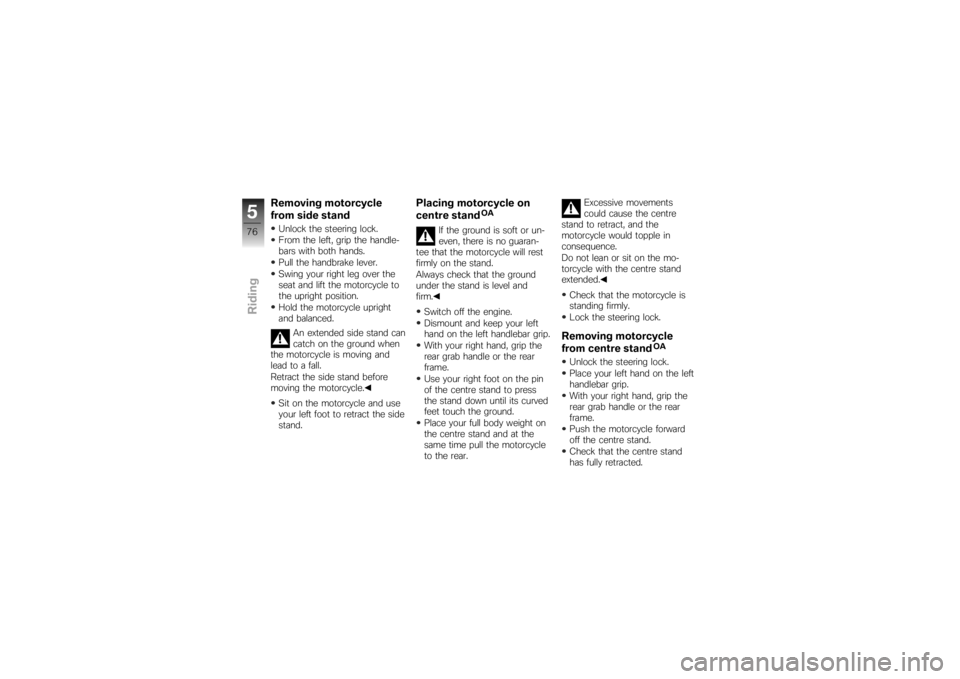
Removing motorcycle
from side standUnlock the steering lock.
From the left, grip the handle-
bars with both hands.
Pull the handbrake lever.
Swing your right leg over the
seat and lift the motorcycle to
the upright position.
Hold the motorcycle upright
and balanced.An extended side stand can
catch on the ground when
the motorcycle is moving and
lead to a fall.
Retract the side stand before
moving the motorcycle.
Sit on the motorcycle and use
your left foot to retract the side
stand.
Placing motorcycle on
centre stand
OA
If the ground is soft or un-
even, there is no guaran-
tee that the motorcycle will rest
firmly on the stand.
Always check that the ground
under the stand is level and
firm.
Switch off the engine.
Dismount and keep your left
hand on the left handlebar grip.
With your right hand, grip the
rear grab handle or the rear
frame.
Use your right foot on the pin
of the centre stand to press
the stand down until its curved
feet touch the ground.
Place your full body weight on
the centre stand and at the
same time pull the motorcycle
to the rear. Excessive movements
could cause the centre
stand to retract, and the
motorcycle would topple in
consequence.
Do not lean or sit on the mo-
torcycle with the centre stand
extended.
Check that the motorcycle is
standing firmly.
Lock the steering lock.
Removing motorcycle
from centre stand
OA
Unlock the steering lock.
Place your left hand on the left
handlebar grip.
With your right hand, grip the
rear grab handle or the rear
frame.
Push the motorcycle forward
off the centre stand.
Check that the centre stand
has fully retracted.
576zRiding
Page 79 of 166
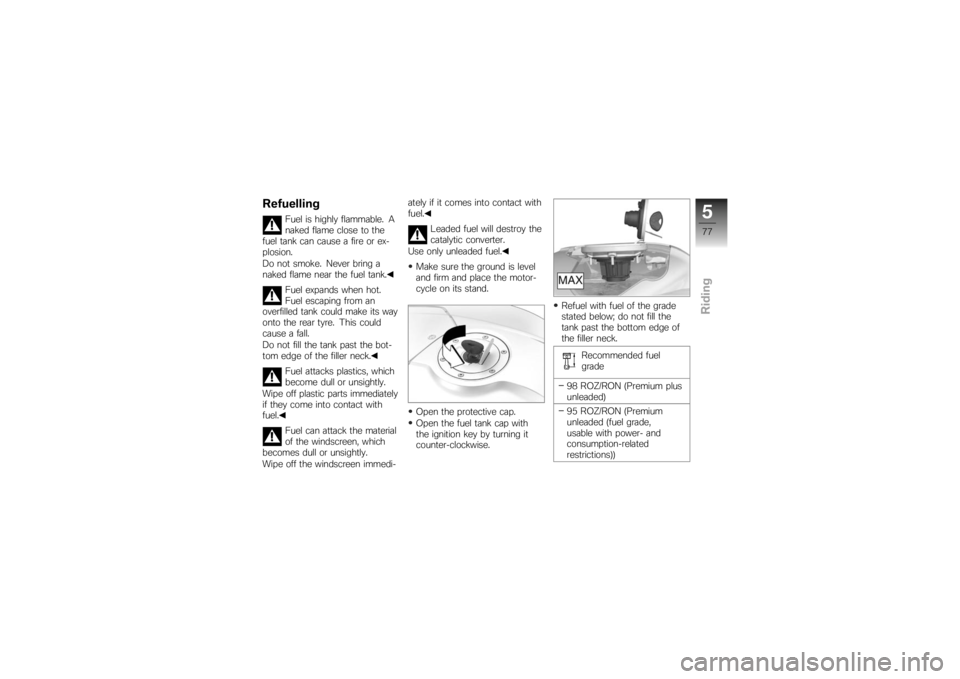
Refuelling
Fuel is highly flammable. A
naked flame close to the
fuel tank can cause a fire or ex-
plosion.
Do not smoke. Never bring a
naked flame near the fuel tank.
Fuel expands when hot.
Fuel escaping from an
overfilled tank could make its way
onto the rear tyre. This could
cause a fall.
Do not fill the tank past the bot-
tom edge of the filler neck.
Fuel attacks plastics, which
become dull or unsightly.
Wipe off plastic parts immediately
if they come into contact with
fuel.
Fuel can attack the material
of the windscreen, which
becomes dull or unsightly.
Wipe off the windscreen immedi- ately if it comes into contact with
fuel.
Leaded fuel will destroy the
catalytic converter.
Use only unleaded fuel.
Make sure the ground is level
and firm and place the motor-
cycle on its stand.
Open the protective cap.
Open the fuel tank cap with
the ignition key by turning it
counter-clockwise. Refuel with fuel of the grade
stated below; do not fill the
tank past the bottom edge of
the filler neck.
Recommended fuel
grade
98 ROZ/RON (Premium plus
unleaded)
95 ROZ/RON (Premium
unleaded (fuel grade,
usable with power- and
consumption-related
restrictions))
577zRiding
Page 80 of 166
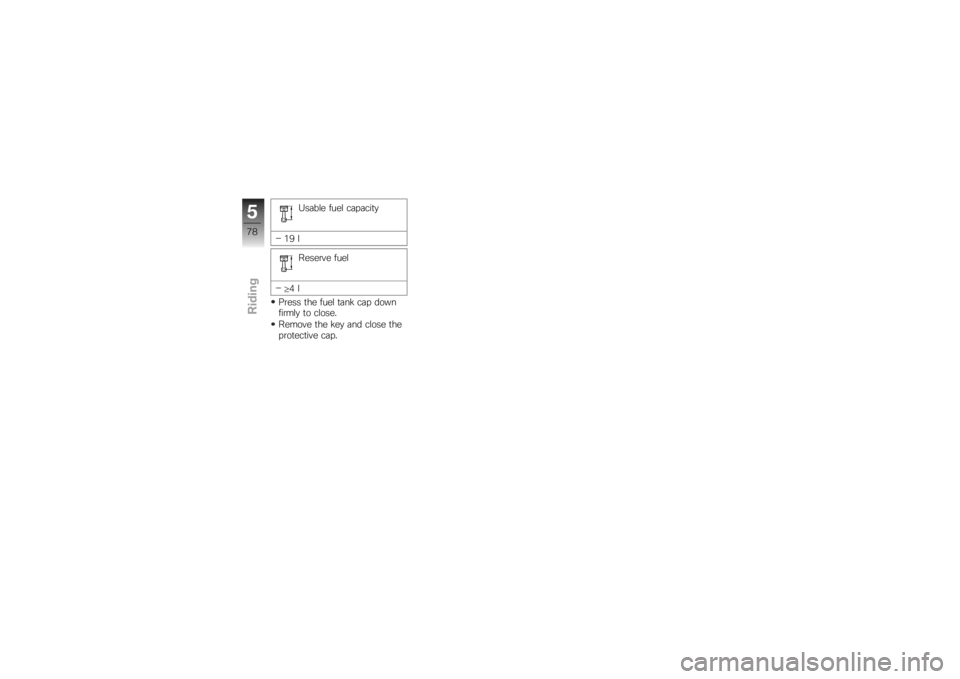
Usable fuel capacity
19 l Reserve fuel
≥ 4l
Press the fuel tank cap down
firmly to close.
Remove the key and close the
protective cap.
578zRiding